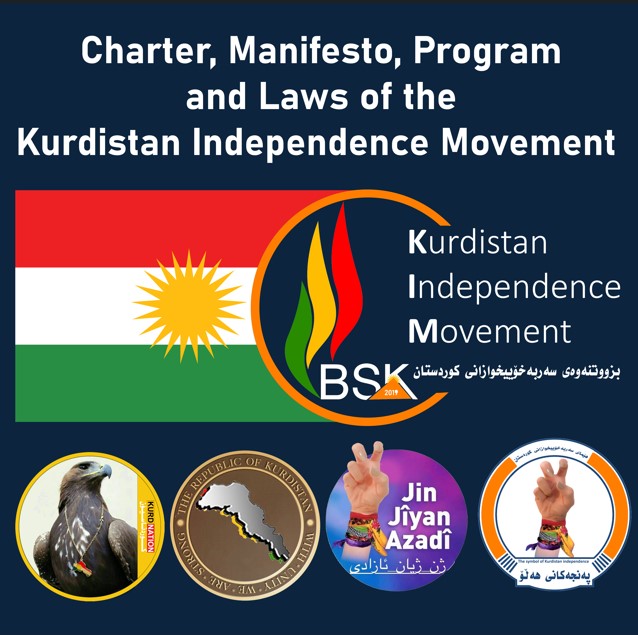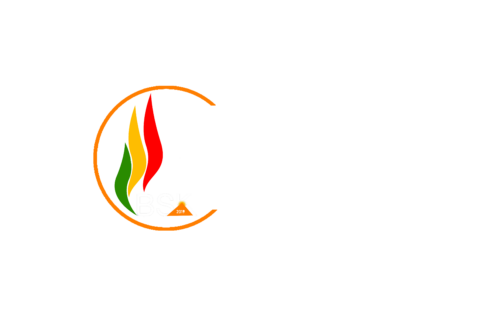Name and Description:
Article 1 / Name:
The movement is called the “Kurdistan Independence Movement” in English and abbreviated as BSK.
Paragraph two / Explanations, analysis, and discussion:
A. The Kurdish independence movement is a political movement structured as a national movement. This movement comprises a group of Kurdish nationalists who believe in fighting for an independent state in eastern Kurdistan. They pursue a common strategy and goal in political, diplomatic, economic, media, and armed arenas to achieve their objectives.
B. The Kurdish independence movement considers independence as the natural right of the Kurdish people and nation. It views all forms and dimensions of struggle as its political, historical, and national duty towards this goal.
C – For this purpose, the first option of the Kurdish independence movement is to exert pressure on the occupying regime of Iran through appeals to the United Nations and international organizations to respect the national rights of the Kurdish people, as well as their right to determine their national destiny for governing their land and country. This means that the Kurdish people, with their free will in all dimensions, should seize control of their land and territory.
D – This is a legitimate demand and an undeniable necessity for the survival of our nation, people, and country. However, if the ruling regime refuses peaceful means despite the demands of international centers and continues its policy of suppression and denial through occupation, the Kurdish independence movement considers it its legitimate right to use all forms and methods of struggle, considering armed defense as its legitimate and undeniable right.
E – The Kurdish Independence Movement, while respecting the right to self-determination and international human rights principles recognized by the United Nations and other international organizations, considers itself justified in striving to establish a temporary government in exile for East Kurdistan.
F – The Kurdish Independence Movement seeks to encourage other forces and parties advocating Kurdish independence to join this coalition, keeping the coalition’s doors open to all political currents that believe in Kurdish independence.
G – The Kurdish Independence Movement has its own emblem, website, and dedicated channels, which define independence and Kurdish identity.
Introduction to Kurdistan
About a hundred years have passed since the occupation of Kurdistan’s land by occupiers under the guise of fabricated countries: Iran, Iraq, Syria, and Turkey. The Kurdish people’s struggle against them has been very costly and sacrificial, but the achievements have been below expectations and costs.
The Division of Kurdistan:
In the year 1514 AD, the Battle of Chaldiran occurred between the Safavid and Ottoman Empires, which ultimately led to the division of Kurdistan between the Ottomans and Safavids in a treaty known as the Treaty of Zuhab or Qasr-e Shirin in May 1639, following a 150-year war.
Once again, following World War I, Kurdistan was divided into different regions in another treaty called the Sykes-Picot Agreement on May 16, 1916:
Northern Kurdistan and Istanbul were allocated to Russia, Western Kurdistan and Syria to France, Southern Kurdistan initially to France and later to Britain, and Eastern Kurdistan to the Persian government.
Initially kept secret, this agreement was later revealed due to Russia’s withdrawal from the war because of the October 1917 Revolution and subsequent civil war. Following Russia’s withdrawal, other countries also retreated from these regions, leading to the division of Kurdistan.
During World War I, the majority of Kurdistan was under Ottoman occupation. However, with the dissolution of the Ottoman Empire, the Allies (France, Britain, America, Italy, and Japan) decided to establish several new states under the Treaty of Sèvres, including Kurdistan and Armenia.
On August 10, 1920, the Treaty of Sèvres was signed, stipulating the establishment of a Kurdish state. However, Turkey, with the assistance of Russia, managed to cancel the Treaty of Sèvres in a conference held on July 24, 1923, known as the Treaty of Lausanne, in Switzerland, attended by Britain, France, Japan, Greece, Romania, Serbia, Croatia, Slovenia, and Turkey.
On this day, Kurdistan practically fell under the occupation of four countries and newly established Iran, Iraq, Syria, and Turkey, with a portion also being allocated to Russia. Later, Kurdistan was divided under Russian occupation between Armenia, Azerbaijan, Georgia, Kazakhstan, and Turkmenistan.
Hundreds of years have passed since the partition of Kurdistan, and occupying regimes have been and still are attempting to erase and destroy the identity of this nation. However, the Kurdish people continue to struggle for the attainment and establishment of the Kurdistan state, sacrificing greatly in this endeavor.
The Kurdish nation believes and has concluded that the only way to defend its existence and perpetuity is the formation of an independent Kurdistan state and government.
The end of the shameful Treaty of Lausanne in 2023 brings hope to the Kurdish people that this time they will not fall victim to the wicked policies of occupiers and the superpowers of the world.
The lack of unity, coordination, solidarity, a single voice, and cohesion among Kurdish political organizations, and prioritizing personal, organizational, and partisan interests, has compromised national and collective interests repeatedly, with national interests often sacrificed for personal and partisan gains.
The land of Kurdistan is divided and occupied among four occupiers (Iran, Iraq, Syria, Turkey, etc.).
The Kurdish nation has a population of over 70 million people.
Northern Kurdistan (under Turkish occupation) 439,812,32
Eastern Kurdistan (under Iranian occupation) 137,281,18
Southern Kurdistan (under Iraqi occupation) 571,949,7
Western Kurdistan (under Syrian occupation) 117,642,3
Germany 319,898,1
Europe and some other countries 691,892,1
Kazakhstan 892,638
Georgia 758,009
Armenia 699,571
Israel 592,622
Afghanistan 312,075
Pakistan 234,006
Egypt 153,561
Sudan 101,00
Bosnia and Herzegovina 8,788
The discourse of federalism, confederalism, and independence encompasses the public and internal thoughts of Kurdistan under Iranian occupation. The proponents of independence are happily positioned at the forefront of these discussions, with the majority, closely aligned with the Kurdish nation, showing no inclination to remain within the artificial geographical confines of Iran. Instead, they demand the withdrawal of Iranian occupiers from the land and geography of Kurdistan.
The Kurdish people in Rojhelat (Eastern Kurdistan) do not wish to repeat the experiences of the year 1357 (Iranian calendar) and have their land and Kurdistan occupied by Iranians once again.
The Kurdish people are certain and believe that neither the Islamic Republic government, nor the Pahlavi regime and monarchy, nor the authoritarian and constitutional monarchy, nor the mujahideen, are ever ready to formally recognize the minimum national rights of the Kurdish people.
In circumstances where political changes and developments based on the desires of nations at the global level are inevitable, and over the past forty years, at least dozens of nations have successfully formed their own governments and countries, undoubtedly, the Kurds are not exempt from this rule, and the time has come for non-Persian nations without government and state to also take steps towards achieving their desires through unity and the formation of a cohesive and effective alliance.
The political and historical necessity, as well as current circumstances, dictate that Kurdish political parties and movements come together around a common table and platform for cooperation and coordination based on common points within the framework of a front or coalition.
The Kurdish independence movement, aiming for freedom, independence, and the establishment of a Kurdistan government in Eastern Kurdistan, is active. However, the ultimate goal and future lie in uniting the Kurdish nation in all parts of Kurdistan into a union, federal, confederal, secular, and democratic alongside each other to form an independent and unified state.
The Kurdish independence movement seeks to urge international bodies and organizations to pressure the occupying regime of Iran to respect the right of self-determination of the Kurdish nation, so that the Kurdish people can govern their land and territory freely through the exercise of their will in all aspects.
However, if the Iranian regime continues its repression and denial of the rights of the Kurdish people through occupation despite the requests of international forums, the Kurdish independence movement will utilize all available means to resist the Iranian regime and pursue its goals.
The Kurdish Independence Movement, while respecting the principles of self-determination and international norms endorsed by the United Nations and global human rights organizations, advocates for the right to establish a temporary government in Eastern Kurdistan in exile.
Kurdistan is a land rich and diverse in religions, beliefs, and various minorities (including Sunni and Shia Islam, Yazidis, Christians, Zoroastrians, and others) that have coexisted peacefully and harmoniously for years, united in the belief in separating religion from politics and adhering to secularism, democracy, and pluralism encompassing all religions, beliefs, and political and non-political ideologies with mutual respect.
The Kurdish Independence Movement, while respecting gender equality, does not overlook gender minorities and believes that living in peace and equality is the inherent right of all gender minorities.
The Kurdish Independence Movement organizes the unified and armed Kurdistan army in defense of the Kurdish nation’s existence.
The Kurdish Independence Movement harbors no enmity or hostility towards anyone or any faction other than the enemies of the land and soil of Kurdistan. Simultaneously, it requests assistance from nations under Iranian occupation (such as Arab Ahwazi, Baloch, Azerbaijani Turks, Caspian, Turkmen, and other national minorities) to unite together based on common interests, common enemies, and common pain, to strive collectively towards freedom and achieving national independence within the framework of mutual cooperation.
The Kurdish Independence Movement, while respecting gender equality, does not ignore gender minorities and believes that living in peace and equality is the inherent right of all gender minorities.
The Kurdish Independence Movement calls on all parties, organizations, and independence-seeking currents to join the ranks of the movement for independence in the direction of national unity and solidarity.
From the perspective of the Kurdish Independence Movement, Kurdistan is a land that has been divided among several countries, including Iraq, Iran, Syria, and Turkey, without the consent of its people.
In its current circumstances, the movement considers itself committed to the struggle for the liberation of the occupied territories of eastern Kurdistan (under Iranian occupation).
Eastern Kurdistan Province: 18,281,137
Kermanshah Province: 1,952,434
Ilam Province: 580,158
Chaharmahal and Bakhtiari Province: 947,763
Kohgiluyeh and Boyer-Ahmad Province: 658,629
Lorestan Province: 1,716,527
Sanandaj Province: 1,493,645
West Azerbaijan Province: 3,265,219
And parts of Hamadan Province: 1,758,268
North Khorasan Province: 867,727
Razavi Khorasan Province: 6,434,501
Official website of the Kurdistan Independence Movement: www.kurdnation.com
Kurdistan Flag
Consists of three colors: red at the top, white with a yellow sun in the middle, and green at the bottom.
Movement Emblem:
A flame in the colors of the Kurdistan flag and the abbreviation “BSK”.
Logo of the Eagle’s Claw, symbol of the Kurdistan Independence Movement:
A hand with the symbol of the Eagle’s Claw, representing soil, nation, independence.






